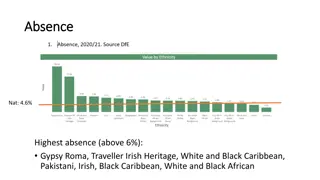Overview of Black Gram (Vigna mungo L.) and Its Economic Importance
Black gram, scientifically known as Vigna mungo L., is a significant pulse crop with various economic uses. It is consumed as dal, used in traditional dishes, and serves as livestock feed. The seeds are rich in protein, vitamins, and minerals, making them a valuable food source. Originating in India, black gram is cultivated in tropical regions and plays a crucial role in agriculture and nutrition.
Download Presentation

Please find below an Image/Link to download the presentation.
The content on the website is provided AS IS for your information and personal use only. It may not be sold, licensed, or shared on other websites without obtaining consent from the author. Download presentation by click this link. If you encounter any issues during the download, it is possible that the publisher has removed the file from their server.
E N D
Presentation Transcript
BLACK GRAM Scientific name: Vigna mungo L. Hepper Family: Fabaceae (previously known as Leguminoseae) Chromosome number: 2n=24 (Diploid species) Dr. Triptesh Mondal Assistant Professor Department of Agronomy M.S.S.S.O.A., C.U.T.M.
Economic importance & uses: Black gram (urd bean/mungo/mash/black maple) is consumed as dal (whole or split seeds, either husked or unhusked) or parched. Urd bean is the chief constituent of papad and also of bari (spiced balls) which makes delicious curry. Haulms of urd bean are used as fodder. Husk and split beans are also used as livestock feed. The black gram plants have deep root system, bind soil particles and prevent erosion. It is also used as green manure crop.
Black gram seeds contains 24-25% protein, 1.83% fat, 61% carbohydrate, vitamins like thiamin, niacin etc. and minerals like Ca, K and Fe. The seeds are very rich source of phosphoric acid. Urd differs from other pulses in its peculiarity of attaining when ground up with water, a somewhat mucilaginous character giving additional body to the mass. In the south, the husked dal is grounded into a fine paste and allowed to ferment and is then mixed with equal quantity of rice flour to make dosa and Idli. Black gram seeds are also fried to serve as savory dish . Urd dal is also used in the preparation of halwa, imarti and vada in combination with other food grains.
Origin and distribution: India is considered as primary centre of origin and Central Asia as the secondary centre of origin of black gram. According to Zokovskij (1962), black gram originated in India from its wild progenitor Phaseolus sublobatous . In India, domestication of black gram may have occurred about 4500 years ago. Distribution of urd bean is comparatively restricted to tropical regions i.e., India, Pakistan, Bangladesh, Myanmar, Srilanka. In north India, black gram is grown in kharif season and pre-kharif season only. But in south India, black gram is grown in all the three seasons. States extensively cultivating black gram in India are Madhya Pradesh, Maharashtra, Andhra Pradesh, Tamil Nadu, Uttar Pradesh and Odisha.
Classification: According to Bose (1932), Vigna mungo (black gram) is subdivided into two subspecies. 1. Vigna mungo var. niger: It includes varieties which mature early and seeds are of black colour. 2. Vigna mungo var. viridis: It includes varieties having longer maturity period. Seeds are of small size and green colour. A number of types with distinguishing characters on the basis of seed colour, flower colour and pod colour are met with. The seed colour may be black or green. The colour of ripe pods range from buff or brown or dark brown.
Area, production and productivity: It is the 4thmost important pulse crop of India after chickpea, field pea and greengram. In world, blackgram production is about 23.4 lakh tonnes annually from 46.7 lakh hectares of area with an average productivity of 501 kg/ha in 2020-21 (agricoop.nic.in). India is the largest producer and consumer of blackgram. Blackgram output accounts for about 10% of India s total pulse production. In India, blackgram is grown in an area of about 3.5 million ha with a total production of 1.7 million tonnes with an average productivity of 486 kg/ha. Andhra Pradesh leads with highest area and production among the states followed by Madhya Pradesh, Odisha, Maharashtra. Karnataka leads with highest productivity followed by Odisha and Andhra Pradesh. In Andhra Pradesh, area under black gram is 2.95 lakh ha with a Production of 2.14 lakh tonnes and productivity of 726 kg/ha.
Botanical description It is an herbaceous, annual plant attaining a height of 30-100 cm. The stem is slightly ridged, covered with brown hairs and much branched from the base. The leaves are large, trifoliate and are also hairy, generally with a purplish tinge. The colour of leaves is green to dark green. The leaflets are 5-10 cm long, broad, ovate and entire. Stipules are small. The inflorescence consists of a cluster of 5 to 6 flowers at the top of a long hairy peduncle. Calyx bracts are linear and exceeding the calyx. There are 5 sepals and 5 petals. Stamens 9 in a whorl and 1 separately, style is hairy and spirally twisted.
The pods are long and cylindrical being about 4-6 cm in length. There are 4 to 10 seeds in a pod. The seeds are generally black or very dark brown or olive black and rarely green and oblong shaped. The split seed of black gram is white in colour. Hilum is concave. The germination of seed is of epigeal type. Self pollination and self fertilisation are the general rules in black gram. The flowers black gram start opening early in the morning and are completely open between 7 am to 8 am. The anthers begin to shed pollen in the evening and pollination is completed by midnight.
Climatic requirement: Generally, black gram is grown in areas which receives annual rainfall of 800 mm. It is a hardy and drought resistant plant and can be grown in areas receiving 650 cm annual rainfall. Black gram requires a hot and humid growing season. Optimum temperature for better growth ranges between 25-35 C but it can tolerate upto 42 C. Urd can be grown successfully from sea level up to an elevation of 1800 m. Heavy rains during flowering stage are harmful and adversely affect the production. Urd bean is grown as kharif and summer or pre-kharif crop in north India but in south and south west India, it is also grown in all the three seasons.
Soil requirement: Urd bean does well on heavy soils such as black cotton soils which retain moisture better. However, it can be grown on all types of soils ranging from sandy loam to heavy clay, except the alkaline and saline soils. Well drained Loam or sandy loam or slightly heavy soils are best suited for urd cultivation. Optimum soil pH range is 5.5 to 7.5.
Recommended Varieties: In kharif: LBG-20, LBG-623, WBG-26, T-9 (in Andhra Pradesh), IPU 0243, WBU 108 (Odisha & Karnataka), IPU 94-1 or Uttara (West Bengal) In rabi (in rice fallow) : Krishna, LBG-611, LBG-22, LBG-648, LBG- 685, LBG-645 (in Andhra Pradesh), OBG 17, Mash 338 (in Odisha), KU 92-1 or Azad Urd 1 (in West Bengal) Varieties resistant to yellow mosaic virus (YMV): UG-218, Pant-U19, DPV 88-31 Varieties resistant to downy mildew: LBG-17, LBG-402, LBG-22, LBG- 611. Pusa-1: It is a hybrid evolved through hybridization between L-151 Type-9. The crop takes 80-90 days to mature. The plants are medium tall and semi spreading. The pods are medium long, 5 to 6 seeded and hairy. The seed or grain yield potential is 1.2 to 1.5 t/ha. It is resistant to yellow mosaic virus (YMV). This variety is suitable for cultivation in Haryana, Delhi, Rajasthan, Uttar Pradesh, Bihar, Gujarat, Maharashtra, Madhya Pradesh and Andhra Pradesh.
Crop improvement in black gram: During pre-independence period (1931-1947), the mode of urd bean improvement was restricted to selections of natural germplasm. In 1948, a variety Type-9 was released and become very popular variety even today. Under all India co-ordinated research project, hybrids like Pant Urd 19, Pant Urd 31, TMV 1, Neelam were released and some disease resistant varieties like UPU 2, NP 16, NP 21, PLU 340 were also released in India during that period.
Field preparation: Field is prepared by one ploughing with mould board plough and followed by two to three cross harrowings each followed by planking. The field should be well levelled and free from weeds. To ensure good germination of seeds, a pre-sowing irrigation should be given. Seed and sowing: a) Time of sowing: Kharif: Sowing is done with the onset of monsoon in the 2nd fortnight of June to 1st fortnight of July Rabi: In south-west and south India, it should be sown in October- November. Pre-kharif: The sowing could be done from the 3rd week of February to 1st week of April. Seed treatment: Seeds should be treated with Thiram @ 2.5 g/kg seed then with rhizobium culture is important. Rhizobium strains like BMBSP 47, DH-2, KU-1 and BDNF can increase the seed yield of urd. b) c)
Seed rate: For kharif crop, 15-18 kg/ha For rabi crop, 18-20 kg/ha For pre-kharif crop, 20-25 kg/ha For rice fallow, 40-45 kg/ha Spacing: In kharif: 45 cm 10 cm In rabi: 30 cm 5 cm In pre-kharif: 30 cm 5 cm In dibbling: 30 x 10 cm. On wet land bunds, dibble the seeds at 30 cm R to R spacing. In Andhra Pradesh (in rice fallows), black gram broadcasting is done in the standing crop of rice 3-4 days before the harvest uniformly at optimum moisture condition. Method of sowing: Line sowing through the seed sowing behind the plough (kera and pora method) or seed drilling or dibbling Plant population: 60-100 plants/m in pre-kharif and rabi seasonand 40 plants/m in kharif season are the optimum plant populations of black gram
Fertilizer application: Rainfed condition: 10 kg N/ha (as starter dose or booster dose) + 25 kg P O /ha as basal Irrigated condition: 20 kg N/ha (as starter dose or booster dose) + 50 kg P O /ha as basal If soil test facilities are not available, 30-40 kg/ha K O can be applied with above mentioned recommended doses. The fertilizer should be applied either at the time of sowing or just before sowing (i.e., 24 hours before sowing) in such a way that fertilizers are placed about 5-7 cm below the seed.
Water management: Irrigation is not required for kharif crop. For rabi crop: Irrigate immediately after sowing followed by life saving irrigation on third day. Irrigate the crop at an interval of 10-15 days depending on the soil moisture. Flowering and pod formation are most critical period related to soil moisture stress. Avoid water stagnation at all crop growth stages. Apply KCl at 0.5% as foliar spray during vegetative stage if there is moisture stress.
Weed management: One to two hand weeding should be done up to 45 DAS depending upon the weed intensity (1st weeding at 20-25 DAS & 2nd weeding at 40-45 DAS). Pre-emergence application of Alachlor (Lasso) @ 1.5 kg a.i./ha. Fluchloralin (Basalin) @ 1.5 Kg a.i/ha in 800-1000 litres of water as pre-plant incorporation (PPI) or pendimethalin @2.0 lit/ha as pre- emergence at 3 DAS followed by one hand weeding 30 DAS. Imazethapyr @100 g/ha applied at 10-15 DAS or @125 g/ha at 25 DAS are most effective.
Harvesting & Threshing: Crop comes to maturity at 80-95 DAS. Upon ripening, black gram pods turn from green to yellow and then to black. Over maturity leads to shattering of pods. In case of irrigated crop, ripened pods can be collected in one or two pickings. If plants come to even harvest, then plants are cut and spread on threshing field to dry. The plants will dry and become black and pods start splitting. The plants are then beaten using sticks and separate seeds from pods followed by winnowing to remove debris.
Yield: Rainfed: 600-700 kg/ha Irrigated: 1000-1300 kg/ha Rice follows: 500 kg/ha Processing: Dal milling: Dal milling is one of the major food processing industry and a there is net loss of 10-15% during milling. Pulsing: Snack food prepared by heating and toasting/pulsing. Cropping systems: In south India: paddy-black gram (in winter), paddy-paddy-black gram (in winter), black gram - Maghi Jowar (in Khammam), black gram tobacco (in black cotton soils) In north India: maize - wheat black gram (in summer), maize potato black gram (in summer), paddy wheat black gram (in summer).
Production constraints of black gram: Moisture stress: Generally, kharif sown crop suffers from moisture stress due to intermittent dry spell during the growth phase. Pre -harvest sprouting: Kharif sown crops mature in August or September. Usually crop is caught in rains at the time of harvest. Hence, there is a sprouting of seeds in the pods attached to the plants causing heavy losses both in terms of yield and quality. Non-synchronous maturity: It is usually harvested by picking. Most of the varieties are non synchronous in maturity. Hence, harvesting is done in 2-3 pickings. Susceptible to diseases: Major diseases in black gram are yellow Mosaic virus , leaf crinkle, powdery mildew.



























